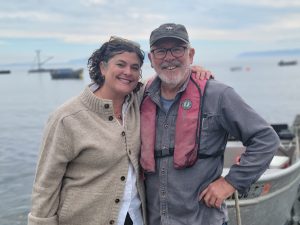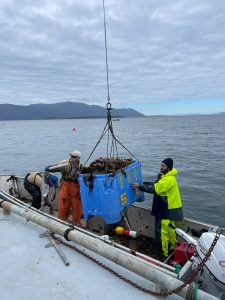June 3, 2024
By Alison Lorenz, WSG Science Writer

Riley Starks with chef and restauranteur Renee Erickson. Photo courtesy of Riley Starks.
Riley Starks had never fished a day in his life and had rarely been on the water when he graduated college in 1972. But he had a whole year ahead of him before he started law school, he needed money, and a friend of his had just bought a boat. When his friend asked Riley to come crew with him that winter, Riley did. “And it was just one of those moments when you have an epiphany,” Starks says. He came back after a winter of crab fishing, sold everything, and bought a boat of his own.
The start of Starks’s long career in fishing had its rough waters. His whole family came down to watch him take possession of his new boat at Ebey Slough, a narrow inlet near Everett. Nervous and unsure of how to turn around, Starks backed his new boat all the way out to sea. When he finally tied up at his destination, he was “so freaked out” he didn’t return for a week. Seven days later, the boat was nearly sunk, water from a leaky shaft log rising almost to the engine’s spark plugs. A nearby fisherman pulled up and offered him a #10 can to bail water out. “He pulled away laughing at me,” Starks says.
But rough waters and all, things fell into a rhythm. Starks was able to make a deal with a canning company early on, giving him a steady income. In addition to fishing Dungeness crab in the winter, he gillnetted for salmon out of the Fraser River in the summer. He tried out herring fishing in San Francisco and eventually got a coveted permit to fish salmon in Bristol Bay, Alaska, which he did for the next 20 years. Though there were bumps along the way – a night they forgot to anchor in San Francisco, a sinking in Bristol Bay (no one was hurt) – Starks did well fishing. “It’s a pattern,” he says. “I did things without really being trained, without knowing – and when doing that, you make mistakes.” But in his case, Starks also learned a lot.
Starks now focuses on a sustainable type of fishing called reefnetting. First developed by the Coast Salish people nearly two millennia ago, reefnet fishing involves anchoring two 40 foot barges to an artificial reef that acts as a funnel, leading the salmon up and over a square net suspended between the barges. A fisher stands on a tall tower or watches through a camera to see when salmon swim over the net. Then, solar-powered electric winches pull up the net while the crew spills fish into the live well. In the live well the salmon rest, swimming into the current and losing any lactic acid buildup in their muscles, until they are hand-sorted. Any unwanted catch is released back into the water unharmed, while the targeted species is bled as it swims.

Harvesting kelp with Lummi Island SeaGreens. Photo courtesy of Meg Chadsey.
The sustainability of reefnetting led Starks to found the Salish Center, one of whose goals is to make reefnet fishing “the primary method for harvesting salmon in the Salish Sea.” The Center promotes reefnetting and the Salish Sea with communities in any way it can. In addition to dinners, festivals, reefnet fishing and seaweed excursions, the Center runs Wave Warrior, Adopt an Orca, and Salish Sea Certified programs – all with the goal of fostering the same love for the Salish Sea that Starks himself radiates.
Then there’s the Center’s newest venture, Lummi Island SeaGreens. One of the first commercial seaweed farms in Washington, SeaGreens fits neatly into the Center’s mission to encourage restoration and stewardship of the Salish Sea. Seaweed provides habitat for a variety of marine life in addition to improving water quality. When his business partner and Salish Center Board President Larry Mellum suggested they get into seaweed, Starks’s first thought was that he didn’t need another project – “but here I am, doing the work,” he says. “It’s exciting, but also challenging to be on the spearhead of it.” To this writer, it seems to fit the pattern of Starks’s life: the willingness to try something new, again and again. And with the Salish Center, Starks has a strong purpose in mind.
The Salish Sea is a uniquely vibrant ecosystem rich with marine life like kelp, salmon and orcas. At the same time, the threats facing the Sea are significant, from overfishing – Starks’s focus – to polluted runoff and habitat destruction. “People need hope,” Starks says of the reason behind the Center’s many projects. “Once they learn about the Salish Sea, it’s life changing. They really care and want to do something.”
“I was born to fish and I didn’t know it,” Starks says. “[Now] I’ve fished these waters for more than 50 years, and I’ve seen the changes. There’s a lot of good news.”
###
Washington Sea Grant, based at the University of Washington, helps people and marine life thrive through research, technical expertise and education supporting the responsible use and conservation of coastal ecosystems. The National Sea Grant College Program is part of the National Oceanic and Atmospheric Administration, U.S. Department of Commerce.
Join the conversation: instagram.com/waseagrant and Facebook.com/WaSeaGrant.
JUN
2024